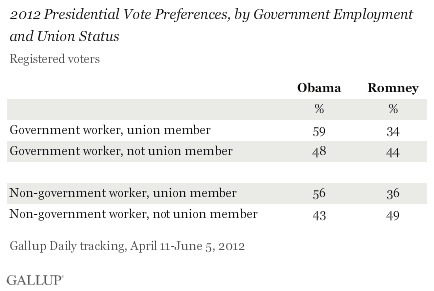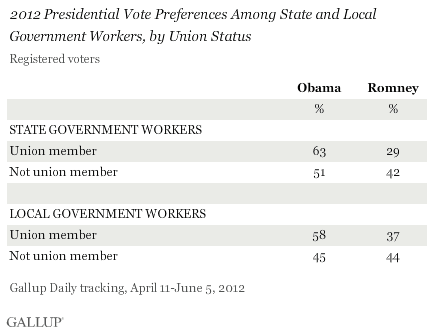PRINCETON, NJ -- A majority of union members say they would vote for Barack Obama in the 2012 presidential race, although their support is by no means monolithic. While 57% of union workers who are registered to vote would support Obama, 35% would vote for Mitt Romney. Workers who are not union members tilt toward Romney over Obama, 48% to 44%.

Roughly 12% of workers interviewed April 11-June 5 in Gallup's Daily tracking who are registered voters say they are union members.
The tilt toward support for Obama among union members is not surprising. Not only have unions been strong and vocal supporters of Democratic presidential candidates historically, but previous Gallup analyses have shown that union members are significantly more likely than nonunion members to be Democrats; this is particularly true for state government employees.
The relationship between unions and politics was starkly evident this past week in Wisconsin, where unions fought hard but unsuccessfully to recall the incumbent Republican governor, Scott Walker, who had pushed for restrictions on state government employee unions.
Union members who work for the government are little different from private-sector union members in their preferences for Obama over Romney. Nonunion workers in the private sector, however, tilt their support to Romney. Government workers who are not members of unions still support Obama, but by a slim margin over Romney.

State government union workers are slightly more likely than the average government union worker to support Obama. Still, about three in 10 state workers who are union members and are registered to vote support Romney, underscoring the finding that union members are modestly diverse in their presidential preferences. There were too few union members working for the federal government in this April 11-June 5 sample to analyze meaningfully.

Implications
Union voters are substantially more likely to vote for Obama than for Romney, at a time when the overall race is essentially tied between the two major-party candidates. Still, a little more than a third of union workers support the Republican Romney -- despite evidence of strong union support for Democratic candidates, including Milwaukee Democratic Mayor Tom Barrett, who lost his bid to oust Gov. Walker in Wisconsin last week.
Much of the focus on union members over the last year has been on government workers, but these union members are statistically no more likely to support Obama than are union members who work in the private sector. Even state government workers, who tend to be more Democratic than other government workers, are just a few points higher than the overall union average in their support for Obama.
All in all, union workers provide a substantial bloc of support for Obama's re-election efforts, although their impact on the presidential race will be limited by their size -- just about 12% of employed voters are union members -- and the fact that a sizable minority support Romney. Still, in crucial battleground states this fall, the vote and efforts of even small groups may end up making a difference.
Survey Methods
Results are based on telephone interviews conducted as part of Gallup Daily tracking April 11-June 5, 2012, with a random sample of 13,376 employed registered voters, aged 18 and older, living in all 50 U.S. states and the District of Columbia.
For results based on the total sample of employed registered voters, one can say with 95% confidence that the maximum margin of sampling error is ±1 percentage point.
For results based on the total sample of 1,643 employed registered voters who are union members, one can say with 95% confidence that the maximum margin of sampling error is ±4 percentage points.
For results based on the total sample of 813 employed registered voters who are union members and who work for the government, one can say with 95% confidence that the maximum margin of sampling error is ±4 percentage points.
Interviews are conducted with respondents on landline telephones and cellular phones, with interviews conducted in Spanish for respondents who are primarily Spanish-speaking. Each sample includes a minimum quota of 400 cell phone respondents and 600 landline respondents per 1,000 national adults, with additional minimum quotas among landline respondents by region. Landline telephone numbers are chosen at random among listed telephone numbers. Cell phone numbers are selected using random-digit-dial methods. Landline respondents are chosen at random within each household on the basis of which member had the most recent birthday.
Samples are weighted by gender, age, race, Hispanic ethnicity, education, region, adults in the household, and phone status (cell phone only/landline only/both, cell phone mostly, and having an unlisted landline number). Demographic weighting targets are based on the March 2011 Current Population Survey figures for the aged 18 and older non-institutionalized population living in U.S. telephone households. All reported margins of sampling error include the computed design effects for weighting and sample design.
In addition to sampling error, question wording and practical difficulties in conducting surveys can introduce error or bias into the findings of public opinion polls.
For more details on Gallup's polling methodology, visit www.gallup.com.
